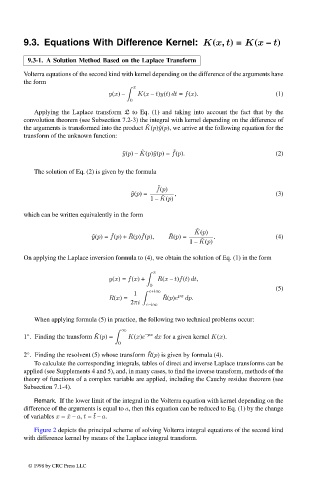Page 482 - Handbook Of Integral Equations
P. 482
9.3. Equations With Difference Kernel: K(x, t)= K(x – t)
9.3-1. A Solution Method Based on the Laplace Transform
Volterra equations of the second kind with kernel depending on the difference of the arguments have
the form
x
y(x) – K(x – t)y(t) dt = f(x). (1)
0
Applying the Laplace transform L to Eq. (1) and taking into account the fact that by the
convolution theorem (see Subsection 7.2-3) the integral with kernel depending on the difference of
˜
the arguments is transformed into the product K(p) ˜y(p), we arrive at the following equation for the
transform of the unknown function:
˜
˜
˜ y(p) – K(p) ˜y(p)= f(p). (2)
The solution of Eq. (2) is given by the formula
˜
f(p)
˜ y(p)= , (3)
˜
1 – K(p)
which can be written equivalently in the form
˜
K(p)
˜
˜
˜
˜
˜ y(p)= f(p)+ R(p)f(p), R(p)= . (4)
˜
1 – K(p)
On applying the Laplace inversion formula to (4), we obtain the solution of Eq. (1) in the form
x
y(x)= f(x)+ R(x – t)f(t) dt,
0
(5)
1 c+i∞ px
˜
R(x)= R(p)e dp.
2πi
c–i∞
When applying formula (5) in practice, the following two technical problems occur:
∞
˜
◦
1 . Finding the transform K(p)= K(x)e –px dx for a given kernel K(x).
0
˜
2 . Finding the resolvent (5) whose transform R(p) is given by formula (4).
◦
To calculate the corresponding integrals, tables of direct and inverse Laplace transforms can be
applied (see Supplements 4 and 5), and, in many cases, to find the inverse transform, methods of the
theory of functions of a complex variable are applied, including the Cauchy residue theorem (see
Subsection 7.1-4).
Remark. If the lower limit of the integral in the Volterra equation with kernel depending on the
difference of the arguments is equal to a, then this equation can be reduced to Eq. (1) by the change
of variables x = ¯x – a, t = ¯ t – a.
Figure 2 depicts the principal scheme of solving Volterra integral equations of the second kind
with difference kernel by means of the Laplace integral transform.
© 1998 by CRC Press LLC
© 1998 by CRC Press LLC
Page 464

